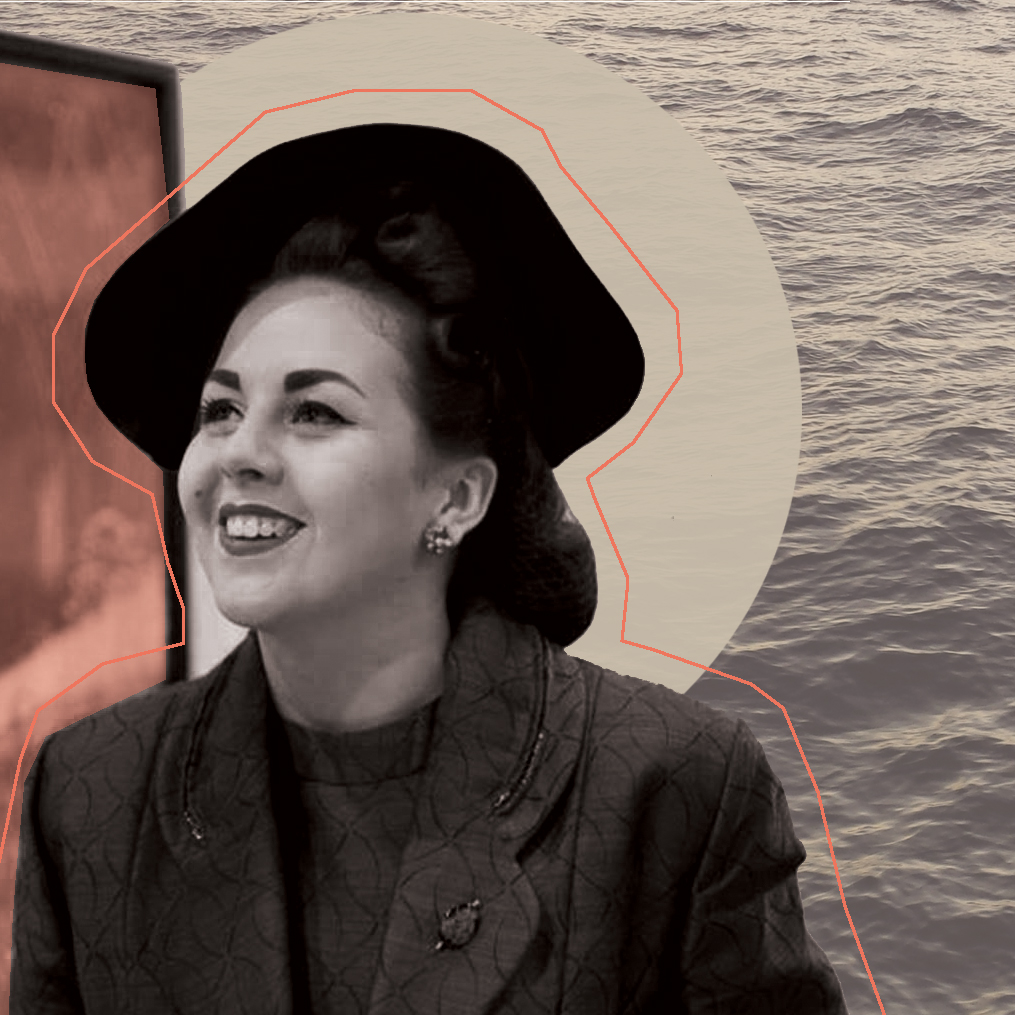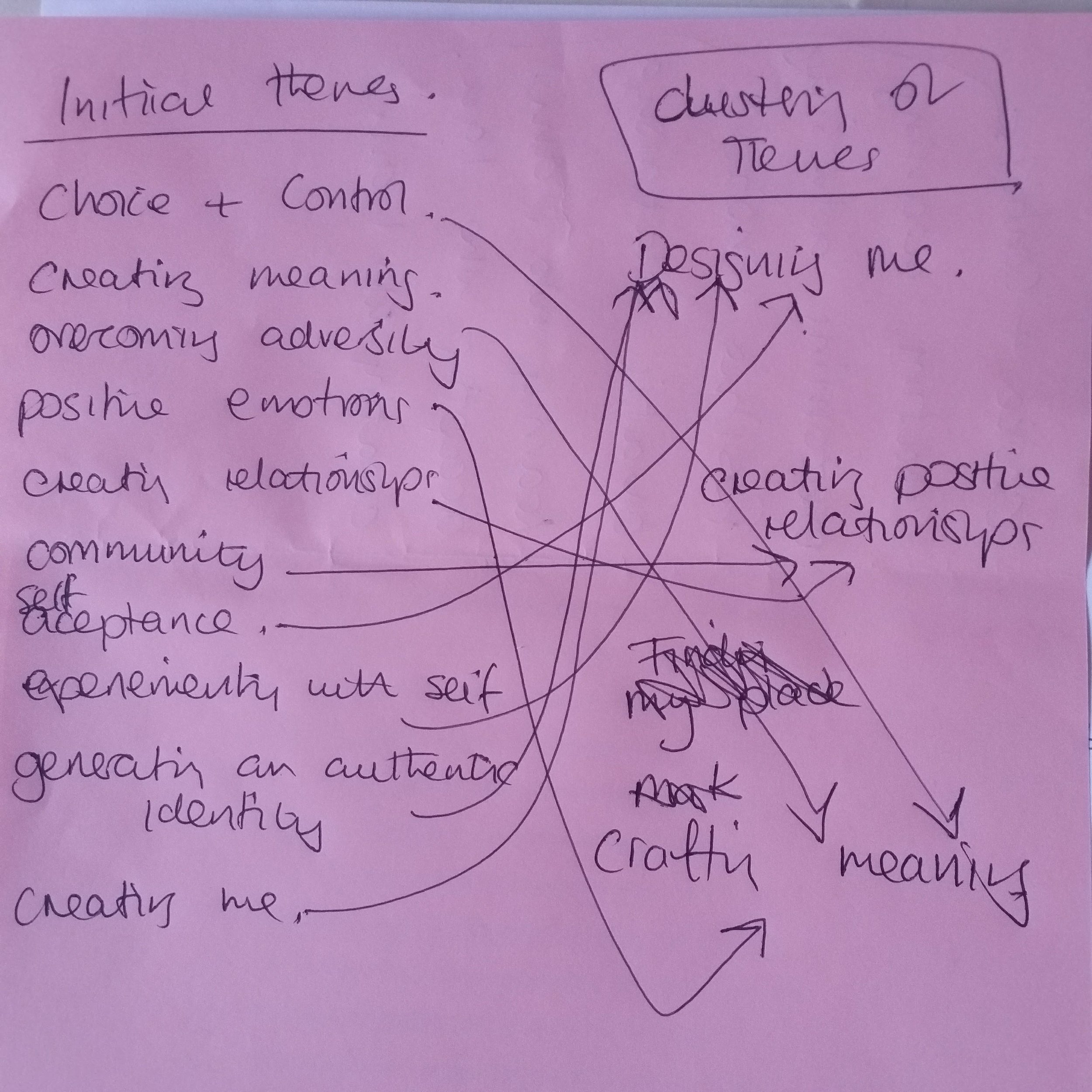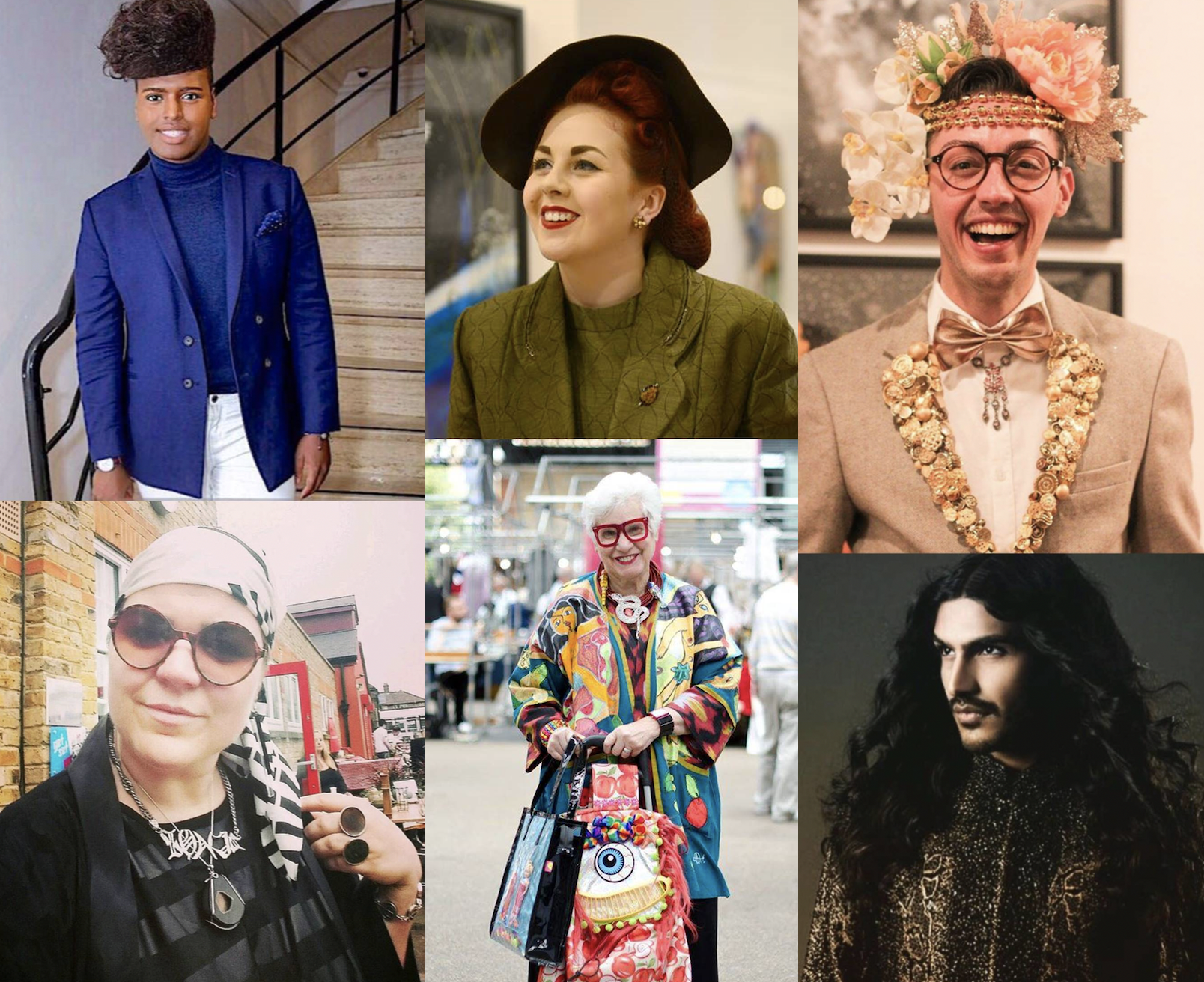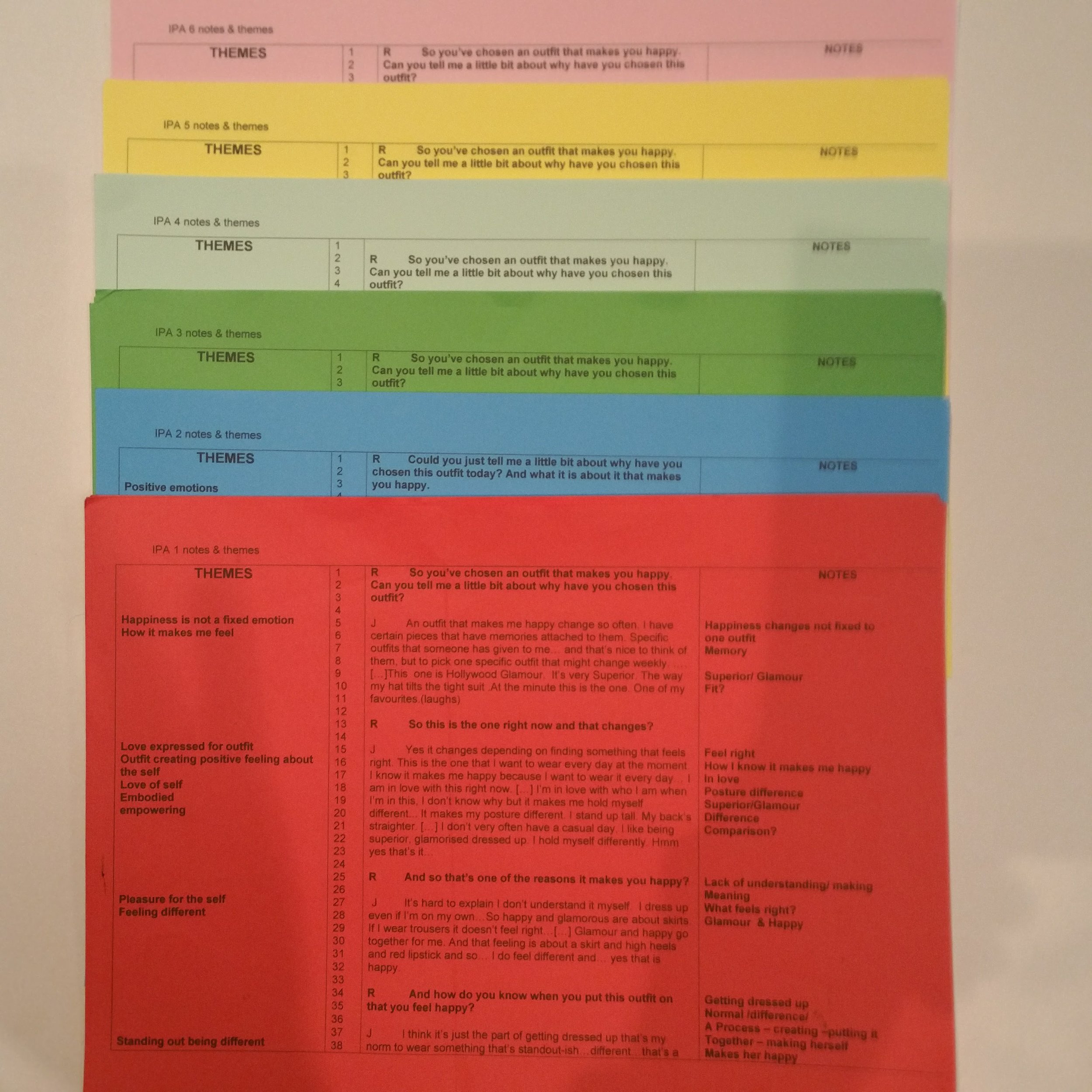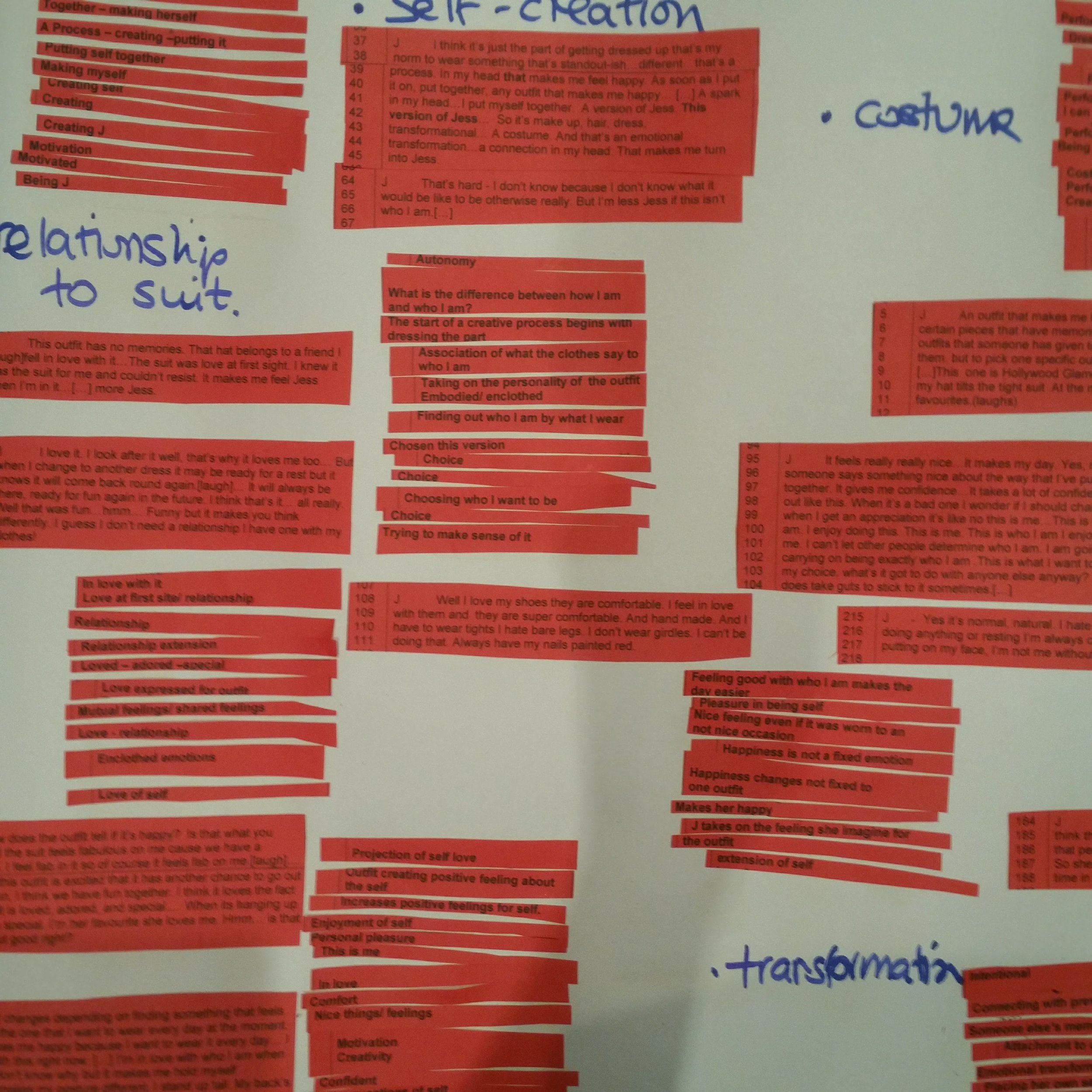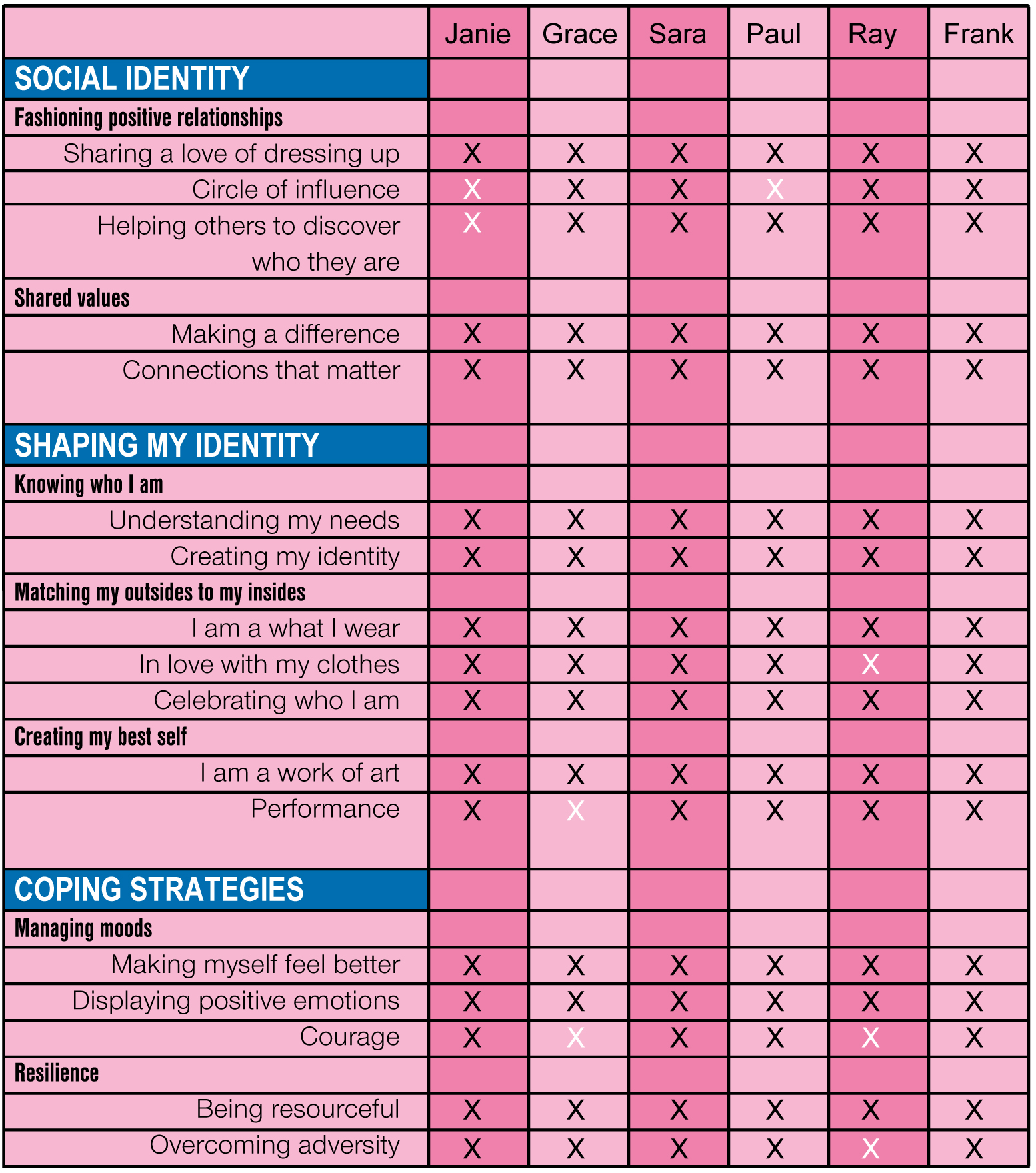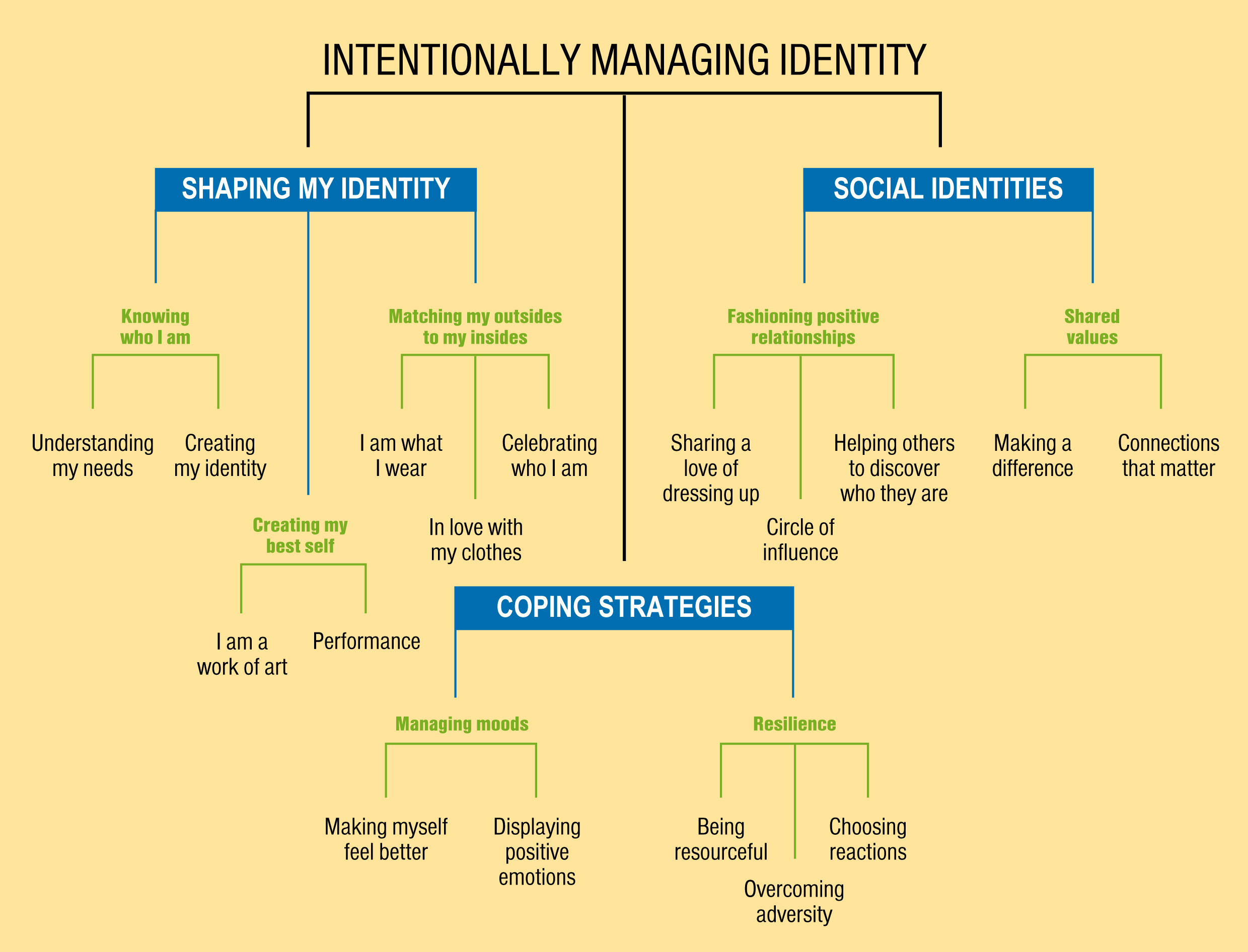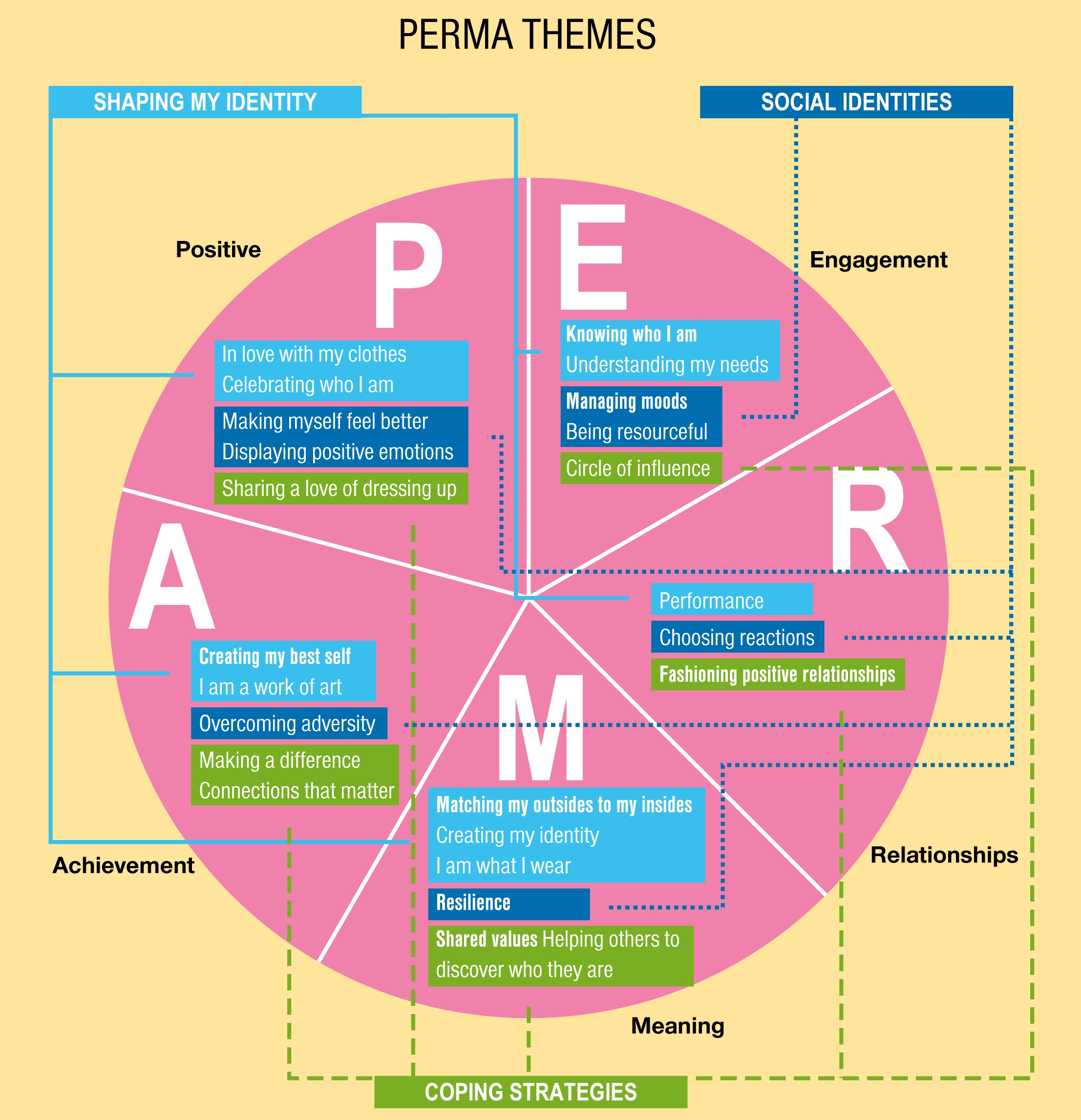Wearing Wellbeing
William James linked fashion and wellbeing together in 1890. [1] He understood that our clothing was an extension of ourselves that could lead to psychological happiness. But when I have attended symposiums or academic events situated in fashion studies I am left with the feeling that we currently believe that fashion is "Bad" — bad for us individually and disastrous for us collectively. Research within psychology has been focused on the pathology of fashion and within fashion studies psychology as a manner to explore how dress and feelings are connected has received little attention.
This confused me. Clothes make me happy.
I have many friends, both inside and outside the business of fashion, for whom fashion is a positive aspect of their lives. My motivation in wanting to understand how we experience wearing the positive feeling of being happy is based on my personal relationship with my wardrobe and the way I feel about dressing. Fashion creates meaning in my life, dress connects me to others, clothes allow me to engage with my creativity, and provide me with a sense of achievement. I wanted to learn if that was also true for others. I wanted to know how it felt to wear happiness. The theory of enclothed cognition supposes that clothes influence the wearer’s psychological processes based on two variables: the meaning we create for particular clothing and the concrete somatic sense that wearing clothing has. I wanted to experience what that meant, emotionally and physically.
Early Thoughts
My own enthusiasm for the topic has driven the study. I asked myself how it feels when I wear an outfit that makes me happy. I hoped to be able to use my personal understanding to shape the questions I needed for my participants. I was able to approach the research with knowledge of my own bias; my feelings that being part of the fashion system has been beneficial to me are part of my personality.
I was concerned that my need to understand how others experienced wearing happiness could result in producing results that were narcissistic. Was I being compelled to poke into this subject to satisfy my own needs? What was I genuinely interested in discovering? Was this of any use to anyone else?
My position as a researcher is inherently subjective and I view the participants of a study as co-producers of the results. I didn’t intend this study to be objective as I don’t believe that the values, beliefs, methods, and previous experience of a researcher can be bracketed to the extent that they will have no effect on a study. After reading everything I could lay my hands on about interpretive phenomenological analysis (IPA) I developed a crush on it as a method. IPA focuses on the particular lived experience of a specific topic to an individual. I wanted to know how one individual felt about wearing this precise outfit at this moment in time. IPA also allows for the researcher to take an active interpretative role in producing the knowledge that is acquired. [2] The position of "myself as a researcher" led me to view that I was as much a participant in the study as those I interviewed. I was aware of my own vested interest in the research question, and the reflexivity encouraged in IPA allowed me to acknowledge my bias without that having a detrimental effect on the results. IPA also recognizes that the participants of the study are the experts on their experience of the question. I wanted the relationship between myself and my participants to be on an equal footing, discovering what was going on in a spirit of adventure. [3]
Sampling issues
How could I approach participants to get the best ones for the study? What if they didn’t understand what I was trying to achieve? I was aware of pressure to make this study work and my need to get this perfect was hindering me in getting on with it.
I was excited when people responded to my Facebook request; someone wanted to take part, what a relief. This whole process felt intensely personal, as if I were being rejected, not my ideas. My sense of identity as a good enough researcher was tied up with this study. In designing this research I was trying to discover what it meant to be a researcher who didn’t conform to accepted ways of asking questions. Why was it so important that my participants had confidence in me as a researcher? I knew that from my first contact with them I was performing this role, including how I dressed!
Interviews
The participants were asked to wear, or bring, an outfit that they considered made them happy and discuss how this made them feel. The justification for asking participants to wear an outfit to the interview was based on a personal view that this would increase a connection to the research question by augmenting the interview and making it a real experience. I had no idea this was going to be controversial. My supervisor queried where I got the idea from, but it had seemed logical to me. I was asking about feelings and clothes why not wear the clothes we are going to talk about? I was aware of the influence my choice of clothes was likely to have on my participants. Reflecting on how I chose to present myself at each interview helped me to understand how I make decisions generally about how I want to be seen and the impact of all of the characteristics of a researcher on a study. I was surprised when my participants mentioned what I was wearing and that they expressed that they dressed for the interview in a way that they thought would generate a happy experience for both of us.
The first interview was daunting. What might go wrong? I had double checked that I knew my questions, had extra batteries, had allowed enough time, had all paperwork printed for signing and it all went smoothly. It felt natural, pleasant, enjoyable. For the first time I felt that this might work.
When I listened back to the recording there was some good data. It was interesting how asking about one particular outfit led someone to talk about their feelings about the way they dressed in a more abstract way. It wasn’t just about that outfit, it became a dialogue about the universal nature of how identity is attached to emotions.
Each interview got easier so that by the third I was completely confident. I started all the interviews with the same question but then let them develop naturally. It didn’t seem necessary to rigidly stick to set questions. It felt at times as if the participants weren’t really listening to what I asked, they were going to tell me what they wanted to say regardless of the questions!
I did become aware of participants wanting to please me. Some explicitly telling me they choose the outfit to make me happy as well as themselves, this was more of a responsibility than I imagined. My participants wanted me to like them, understand them and it felt like a relationship—I wanted them to like me too. I felt as if we were sharing something significant that bonded us together, as if we became a subculture based on being this particular group involved in this study at this time.
Transcriptions
Each transcription made me feel as if the participant had taken residency in my head. I dreamt about them! I felt as if I were drowning in data, I couldn’t remember why I thought this study would be a good idea, I thought seriously about giving up and fantasized excuses for walking away. I decided I hated fashion. I thought psychology was a waste of time. I wished I had never heard of positive psychology. The transcription stage was my all-time low point.
Analysis
I really don’t think it was a good idea to have six interviews; it was daunting having vast amounts of information and working it into usable data. Each transcript could have been a case study and I would have preferred to have time to devote more attention to merging themes individually. I felt I was skimming the surface because of time restraints.
I found it challenging analyzing text on a screen, so I printed each set of transcripts on different coloured paper and did old fashioned cutting, sticking and moving around. That felt like a breakthrough, and suddenly combining themes was visible. I was then able to take the large posters I had made and see the bigger picture. I kept changing my view point from overview to details. This helped. As did reminding myself that this was about being true to my participants, not to my own needs of sounding clever and being a good researcher.
After a supervision session I finally felt there was some cohesion to the results. I needed to realize that I couldn’t discuss it all. The choices I made about what to focus on were not about being right or wrong. I had to go with my intuition. The guidelines on how to analyze IPA data are flexible rather than prescriptive; I took this literally and applied my own creative approach to viewing the data I collected. I began following the "typical" method outlined in Smith (2015): read, then re-read transcripts, note initial thoughts, develop emerging themes, look for connections and make links for each set of data before moving on to the next transcript. Each transcript was a story in its own right, full of rich language, nuanced emotions, in-depth personal history, and endless paths to themes. I followed a process of focusing intensely on details, individual words and actual sentences, before opening back up to intuitively sensing the main ideas each transcript was trying to convey to me. Smith (2015) talks of finding gems in the transcripts; I discovered that each participant gave me one stand-out gem which summed up the way that I felt they had experienced the research question and that every theme that emerged contained one gem from different transcripts that highlighted where that idea grew from. This feeling of expanding and contracting continued as I developed superordinate and subordinate themes across the data.
I was also aware that the data could have been analyzed in many different ways, not only by a different researcher but also by me: the reading of these data was particular to a certain time-frame and mind-frame.
Writing Up
Actually turning the results back from tables into a narrative required a different vision again. I wanted to distance myself from data and create a story. One of my original intentions for this study was to produce a visual representation of my findings, but I had been discouraged as this wasn’t usual and there was no precedent for doing so in the department where I was based. As a graduate level student with an outside perspective I was aware of pressure to conform in order to get a good mark. But at this point I didn’t want to comply, I wanted to do this my way, I didn’t want it to be about producing a perfect IPA, and plus I hadn’t done this before, so I needed to accept that good enough would have to be OK.
I felt even more pressure when I thought about the gift my participants had given me and how it was my job to make sure that it was wrapped beautifully and displayed with pride.
Final Thoughts
I came through it unscathed and wanting to do it again.
I loved the interview stage best.
Transcription is painful but not the worst part of the process.
Analyzing data and grouping themes is horrible; it reminded me of being in therapy and not wanting to accept the ideas that are floating around in your mind. You know that all the denial in the world isn’t going to make them go away so the sooner you accept the inevitable the better.
If I could research for fun and not have to be judged I would like it more. I loved the procedure (in the end) but the fear of getting it wrong, not being good enough and letting my participants down was crippling. At times I came very close to giving up.
The fact that I believed that fashion can be good for you kept me going. That and falling a little bit in love with my participants.
I suspect that fear of being judged has been the one factor in this process that has created the most stress. If I had been able to let that go, the idea that once this study was out there it would be open to criticism, I would have been more relaxed about interpreting the data.
I found it daunting having to attach my findings to theory. I would have liked the results to stand alone, outside of a need to fit in with pre-existing concepts. That feels as if it just about sums up the story of me as a researcher. I don’t actually want to fit in, or undertake research in the way it is supposed to be conducted, but the need to be accepted by peers pulls me to conformity. If fashion is about the paradox of negotiating individuality and social approval, then carrying out this study has highlighted that tension for me in other areas of life.
I had a sense of loss at having to let go of so much of my participants’ voices in the write up. I felt forced by the marking criteria to create an article which was inauthentic. I lost my own voice in the write up along with the personality of the transcripts and the depth that the data revealed was squashed under the need to add theory. I wish that academia allowed researchers to be true to themselves and their results without the pressure to hide under a fake-field of impenetrable notions of the correct way to write up research. My intention to produce a study that took a different approach and produced originality was misplaced in the process of conforming.
What Next
My discoveries propose that fashion plays a substantial role in flourishing among the six participants who took part in the study. The results produced more questions than answers for me, questions which I feel deserve further exploration: Is the manner in which my participants intentionally manage their identity relevant to other groups? How can this help us to understand the way in which dressing connects to wellbeing? Do all the themes need to be in place for flourishing to occur? Exploring how this particular group of participants experienced wearing an outfit that made them happy has contributed to the possibility of viewing fashion from a positive psychology position which could impact further research. This includes whether having a relationship with our clothes, a deep attachment to knowing who you are and how you express yourself sartorially, can have an impact on the amount of clothes we buy. If we are satisfied with how we feel in our clothes, not looking to constantly meet internal needs with something new, then would we naturally consume less? Does individual flourishing fashion translate to a way in which the fashion system could change? What would it take to create a ripple effect of thriving throughout the business of fashion?
I wonder if the links to dress and flourishing could be explored using social media. I imagine trawling Instagram to analyze hashtags such as ‘happy dress’ as just one such way I could explore this. Could IPA findings be applied to the design process and discover ways the data could be used to create garments that reflected identity needs in particular groups? Using research on how we feel when we dress rather than how we look would be a novel approach to setting a design project for fashion students that could impact their own experience of wellbeing as well as creating garments that embedded PERMA-wear.
My hope is that I can continue to produce research to accentuate how positive fashion consumption practices create wellbeing and persuade those accountable for creating fashion that flourishing is good for business as well as individuals.
Notes
[1] Watson, C.A., 2004. The sartorial self: William James's philosophy of dress. History of psychology, 7(3), p.211.
[2] Smith, J.A. ed., 2015. Qualitative psychology: A practical guide to research methods.
[3] Smith, J. A., & Eatough, V., 2015. Interpretative Phenomenological Analysis. Analysing Qualitative Data in Psychology. (pp50-67) Sage,London

